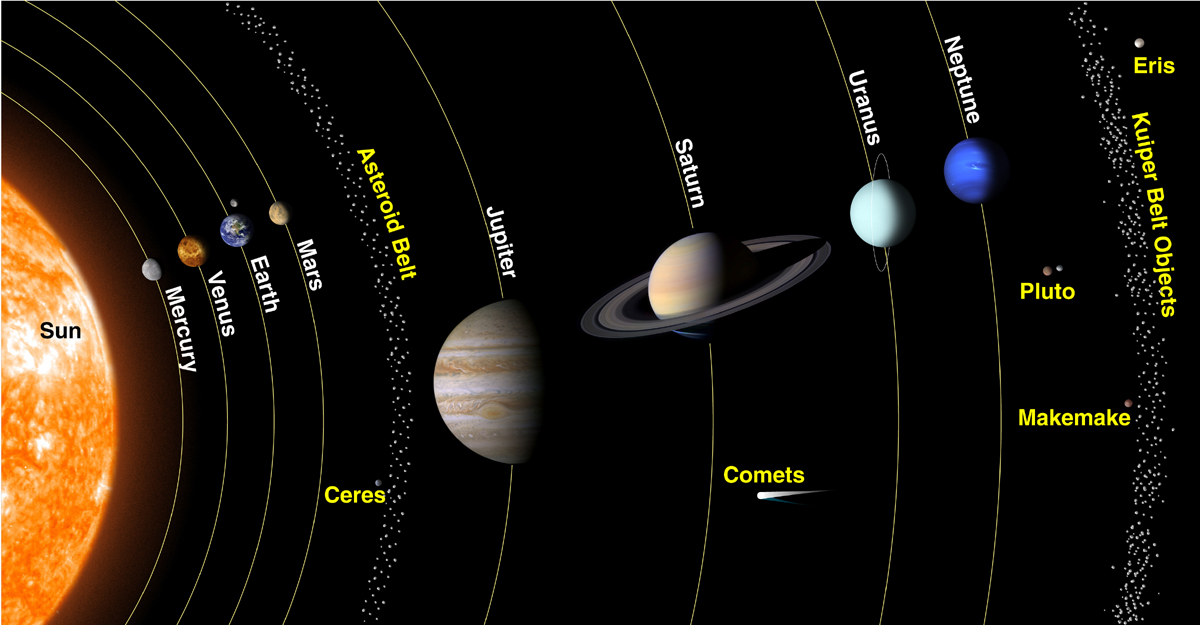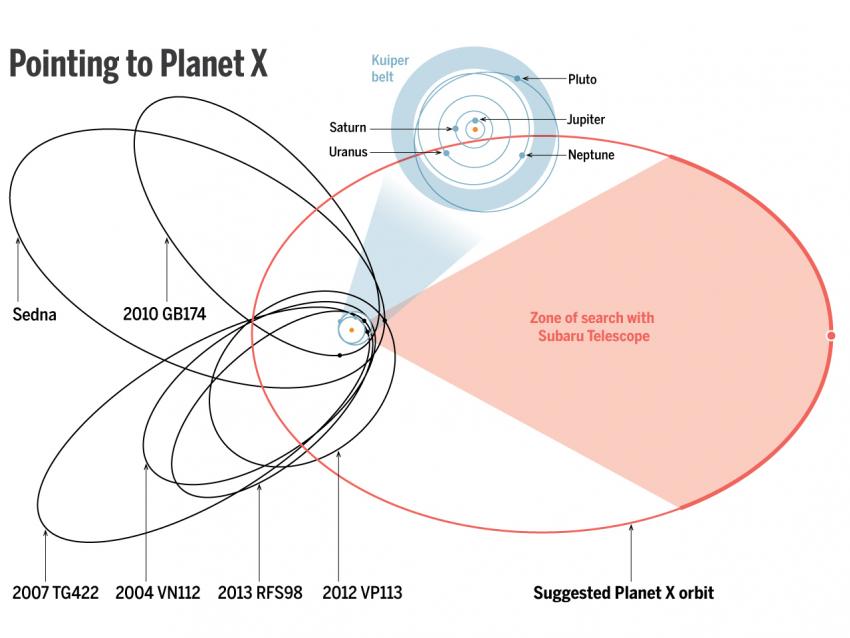Drums in the Deep: A Ninth Planet?
[Click images to embiggen]
From the first moment humans looked at the sky, their eyes — with or without aids — could see five wanderers against the celestial backdrop: Mercury, fleetingly visible outside the Sun’s glare; Venus, so bright it can cast a shadow (Eosphóros at dawn, Phósphoros at dusk); Mars, its brick-reddish hue apparent even at aphelion; Jupiter, second to Venus in brightness; and Saturn, about as dim as Mercury – though someone with exceptional vision might just discern the slightly elongated shape that would later prove to be its rings.
And there the count of the solar family remained until the late 18th century, when telescopes and the mathematics of trajectories got sophisticated enough to enable astronomers to make and test predictions. At that point, the Herschel siblings established that Uranus was not a star but the planet next out from Saturn. A little less than a century later, Le Verrier noticed the “tugs” at Uranus’ orbit. Based on these, he predicted, then visually found, Neptune. But Neptune’s orbit showed irregularities also, plus its mass did not totally account for the Uranian perturbations either.
So the search started for Planet X (pedantically speaking it should have been IX, but X is the standard denotation for an unknown). And that’s when things stopped being simple.
The next iteration of the methods that had added Uranus and Nepture to the solar herd yielded Pluto. The problem with Pluto, which led to its eventual dethronement as a planet, is that there are many Pluto-sized planetesimals in the asteroid and Kuiper belts and in the Oort cloud — several with accompanying moons, like Pluto has Charon. Amusingly, many carry names of female gods or heroes and/or from mythologies beyond the Roman in a belated effort to change the heavily skewed naming ratio of the major planets.
So either Pluto of tiny mass and eccentric orbit did not deserve the distinction of being called a planet – or Vesta, Ceres, Eris, Sedna et al had to be included in the roster (side note for SFF doofs like me: Eris, named after the goddess of discord, was originally called Xena; its attendant moon is officially called Dysnomia, the Greek term for Lawless… as in Lucy Lawless, who played Xena the Warrior Princess; personally, I think they should have stuck with Xena and Gabrielle, but I’ll admit to some lack of objectivity). To the relief of both astronomers and astrologers, scientists drew the line at entities so small that, even if they’ve attained roundness, don’t have the oomph to either fling or pull planetesimals in their vicinity.
Yet the idea of a giant planet or brown dwarf hiding in the outer darkness has too strong a hold on our imagination. Starting with paleontologists Raup and Sepkoski, scientists proposed such a distant lurker whose orbital movement might have caused impact events resulting in the mass extinctions that occur on Earth about every 27 million years. For obvious reasons, they called this hypothetical planet Nemesis (Retribution). The long, systematic hunts for Nemesis yielded nothing except the conclusion that nothing larger than Saturn is rolling for several thousand AUs beyond Neptune. That’s disappointing, but there’s a large size gap between Saturn and Pluto where a respectably sized outcast can still dwell.
The productive game of checking for orbit irregularities and sweeping/herding behavior got applied again recently, when several astronomers (first Sheppard and Trujillo, then Batygin and Brown – all Kuiper aficionados and decisive influences in demoting Pluto) noticed a pattern in six “sednoids” – largish denizens of the Kuiper belt. Their behavior indicated that they had been disturbed by something large. So Brown and his collaborators fed the pertinent details to a simulator… and out popped the prediction of a planet at least 10 times as massive as Earth (i. e. Neptune-sized) with a highly eccentric, off-center orbit – a victim and survivor of ejection from the inner regions of the solar system during the early stages of its formation.
Brown was meticulous in exploring and evaluating all other possible explanations of the planetesimal disturbance pattern, just as Boyajian and her co-authors did with the anomalous brightness dips of KIC 8462852. The hypothesis of a Neptune-sized planet at that region passes the Occam’s razor criterion. But only one thing will make Planet Nine move from hypothetical to real: seeing it with a telescope. So some astronomers have been sweeping the starry dark with high-powered wide-field telescopes, while others have been comparing time-lapse photos to see if a bright needle has moved relative to the rest of the haystack.
If Planet Nine proves to be real, it will give us important insights into the workings of our solar system and will help us judge how unusual it is compared to other systems found by the industrious Kepler telescope. And if its existence is confirmed, the arguments about its specific details will pale in comparison with those over what to name it. Some want it called Jehosaphat; others, Janus. But I propose Tiamat, the exiled Great Goddess of the Deep.
Primary sources
Trujillo, Chadwick A.; Sheppard, Scott S. (2014). A Sedna-like body with a perihelion of 80 astronomical units. Nature 507: 471.
Batygin, Konstantin; Brown, Michael E. (2016). Evidence for a distant giant planet in the Solar system. The Astronomical Journal 151: 22.
Related article
Images: Top, current view of the solar system (credit: NASA’s Space Place via http://spaceplace.nasa.gov/ice-dwarf/); bottom, the predicted orbit of Planet Nine (credit: (data) JPL; Batygin and Brown/Caltech; (diagram) A. Cuadra/Science)




Tiamat makes good sense to me too – I like it.
I do also like Tyche the benevolent sister of Nemesis which was suggested for an earlier incarnation of the long running theme of an extra planet / star far out in our solar system. A theory that long predated Mike Brown’s rather egotistical and arguably over hyped and beaten up latest speculations – with admittedly some suggestive but far from conclusive evidence.
Oh & we already and forever have a planet nine called Pluto which will hopefully be reinstated ASAP and I think logical definition of planet should include Ceres and Eris and the other ice dwarfs too. (Cere’s being as Isaac Asimov once called it, the four and halfth planet. Oh & no, we wouldn’t have to force all schoolkids to remember all their names any more than we expect them to be able to name all the exoplanets too! )
I’m glad you like the name suggestion!
Many dwarf planets of the solar system were found at the same time as Pluto, or even before, and were deemed not planet-ranking without fanfare or fuss. It’s a matter of definition: planets, in addition to orbiting a star and being large enough to be round (or elliptical — i. e. not lumps) must also be large enough to sweep or herd smaller objects in their vicinity. By all criteria, including the attriutes of its orbit (highly eccentric and out of the ecliptic), Pluto is clearly a dwarf planet of the Kuiper belt, in the same category as Eris, Sedna, Haumea and Makemake. It’s not a main-sequence planet.
The issue of memorizing name is neither here nor there. For one, most exoplanets still have numbers like Kepler-21b (hardly memorable). For another, most exoplanets — as well as Planet X itself — are not known to exist with 100% certainty; they’ve been mostly conjectured from brightness dips in stars and require independent confirmation.
I agree, Tiamat is a good name (and goes along with Sedna, the Inuit goddess of the sea). I look forward to the inevitable flyby–I hope it happens in my lifetime!
It’s amazing how personal many people took Pluto’s “demotion.” As humans, we are obsessed, perhaps a bit too much, with categorization; all the more with categories we learned in childhood, which are the hardest to dislodge.
I’d love to see the planet confirmed — if it is, I’d say a flyby is inevitable. And I agree about the weird angsty-feely shenanigans linked to Pluto.
I also like Tiamat; the suggestion’s a good one.
The planet’s confirmation would be fascinating, and I see the further understanding that would provide about how the solar system works having as much of a hold on the imagination (right alongside the inevitable fuss that would ensue about what to name it).
It’s not necessarily the only name that would fit the planet, if it were confirmed, but it’s a better choice than the other proposed monikers I’ve heard!
Tiamat would be an excellent name for Planet 9, if and when it’s existence is actually confirmed. I too will be looking forward to the inevitable flyby after such a discovery.
I’m not entirely looking forward to the shenanigans around naming the “new” planet, however. I’ll be on tenterhooks the entire time. I can only hope someone as sensible as Venetia Burney puts forward the winning suggestion!
This xkcd comic usefully breaks down the possibilities for undiscovered planets in our solar system- link. At least we can rule out the bugs around the porch lights as candidates for planet nine!! *laughs*
xkcd is so good at science! *smile*
Hey, Athena, have you seen the latest Centauri Dreams post on agriculture on other worlds? It’s nice to see these less glamorous yet vital subjects addressed, and to have people in other disciplines (in this case, an agronomist) invited on the interstellar tour bus. It’s a terrible turn of phrase, but this sort of thing brings plans for space colonization down to Earth.
Especially when it often seems half the readership is convinced we won’t need to worry about messy little issues like eating or breathing because we’ll inevitably become god-like uploads. At least as long as no one pulls the plug. *laughs*
I haven’t — many thanks for pointing it out, Chris! I’ll read it more carefully tonight. I’m delighted that someone is tackling issues like these. They’re potential dealbreakers for space travel.
You’re very welcome! I knew you would be interested. I agree, these issues are the potential dealbreakers. In many ways propulsion is a far more tractable challenge than crew health and life-support. Launching a starship won’t don’t us much good if the crew dies in the first decades from air poisoning caused by an ecological imbalance or some other subtle, unanticipated issue.
BTW, I wrote another article for Paul, set for publication on the 25th. I won’t give away any spoilers, but I’ll be touching on long-generation ships!
The Kokkinidis article is a good springboard for further discussions — it’s more of an introduction and there are more alternatives (and issues) than he was able to discuss in the allotted length.
Looking forward to your own article!
Yes, that article was an excellent springboard for discussing this vital topic. I hope he will return with followup installments. There certainly wasn’t time to discuss everything.
I was somewhat bemused by Kokkinidis’s insistence that we must bring cows, pigs, and other such large animals into space for meat production. Considering the sheer mass that must be flown and the negative impacts intensive animal husbandry has on workers and people living nearby, taking such techniques into a sealed environment seems like a nonstarter. I hardly eat any meat, though, so I am not as set against a vegetarian diet as some people seem to be. I think it far more likely that astronauts will turn to meat substitutes and/or alternative sources of protein like entomophagy rather than insisting on a hamburger every day.
My article is finally up! I’m arguing that generation ships will not be the nightmarish environments some people envision them as being, and cannot be like that if they are to succeed.